 Chapati also called `flatbread` is the most common accompaniment to the Indian dishes. It is easy to prepare and is largely made in various Indian household as breakfast, lunch, evening or dinner food item. It has soft texture and is usually round in shape but the size may vary.
Chapati also called `flatbread` is the most common accompaniment to the Indian dishes. It is easy to prepare and is largely made in various Indian household as breakfast, lunch, evening or dinner food item. It has soft texture and is usually round in shape but the size may vary.
History of Chapati
The word `Chapati` can be defined as "flattened round" in Indian languages. It is noted in Ain-i-Akbari, a 16th-century document, by Mughal Emperor, Akbar`s vizier, Abu`l-Fazl ibn Mubarak. Chapati is a form of roti or rotta meaning bread. These two words are often used interchangeably.
Ingredients of Chapati
•Four cups of whole-wheat flour
•Two cups of water
•One-fourth teaspoon of salt
•A small bowl of safflower oil
Method of Preparing Chapati
•Mix the flour and salt. Pour water, in the centre of the flour and start kneading the dough. Keep adding water until soft dough is prepared. The dough should be such that it does not stick in the hand. One can use little oil in between so that smooth dough is made. Cover the dough and keep it aside.
•Take a handful of dough and roll it in a ball. Roll the ball in flour and flatten a little with palm. Brush or pat one side with oil and lightly dip the oiled side in to the flour. Fold over in half, covering the oiled side and fold in half again. Pinch the edges together.
•Dip both sides in flour and roll out until thin and even. After a somewhat round shape, place the chapatti for baking on a frying pan, which is called tawa in India. Wait till the chapatti bubbles up and the bottom has brown spots. Dab with oil and flip it over cooking it until it is lightly brown on bottom. The chapattis should cook in two to four minutes.
•It can be wrapped in silver foil and kept in hot pot and this can be consumed within couple of hours.
The Chapati can be consumed by everyone. It is ideal to relish this with a variety of cooked vegetables, lentils, pickles, chutneys and yogurt. Some people also prefer to consume it by dipping in the hot tea.




















